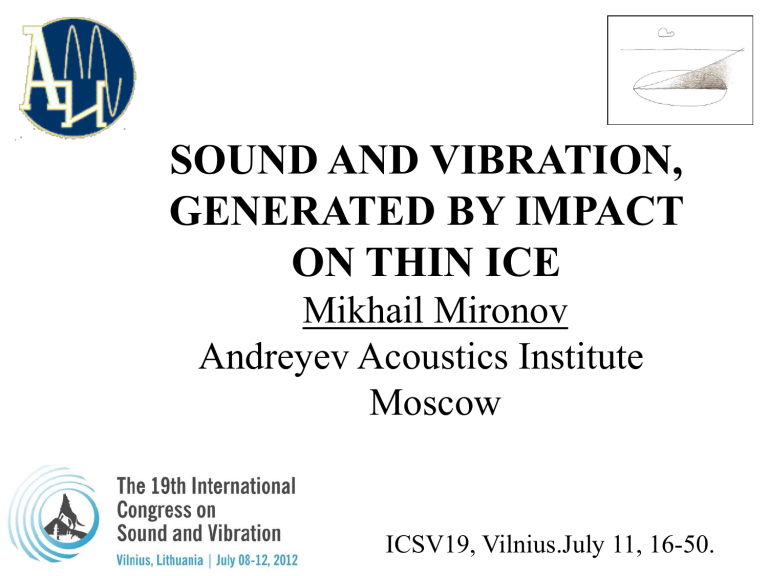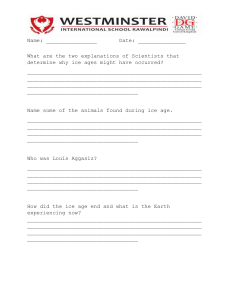
SOUND AND VIBRATION, GENERATED BY IMPACT ON THIN ICE Mikhail Mironov Andreyev Acoustics Institute Moscow 1 ICSV19, Vilnius.July 11, 16-50. The main goal of the talk is experimental illustration of some delicate point in the problem of sound generation by vibration. This is coincidence frequency effect. The statement of the problem is as follows. impact point air thin plate water 2 z The field of the pressure in air may be find formally by means of double Fourier transform (all indications are standard): x p( x, z, t ) (2 ) i a 2 ddkP(, k , z )e it ikx i ( / ca ) 2 k 2 z e F ( , k ) P( , k , z ) 2 2 h ( k 2 ) 1 / 2 2 12 1 Eh 3 k 4 ( / ca ) k i w 2 bifurcation points - sound in air poles - bending waves in the plate Singularities in the integrand 3 z x Im k k-plane Re k bifurcation points poles What happens, when poles and bifurcation point appeare to be close each other at some frequency? Or, what happens if propagation velocities of sound in air and bending wave in ice plate are coincided? This is just coincidence situation. Strong interaction between vibration of solid (ice) and sound (air) is realized at the coincidence frequency The goal of the presentation is the experimental illustration of the strong effect. So, we pass from the dry theory to the natural, vivid and beautiful experiment. 4 This is the forest pond with thin (~3 cm) ice layer. Trace 2, 155.6 m Trace 1, 92.6 m Photo of the pond, Autumn 2005 Space photo of the pond (Google maps) The impacts over ice were made at one bank of the pond and were detected (in air) at the opposite one. 5 1 - 97 м Trace 1 T 150ms 150 ms 2 - 157 м Trace 2 T 245ms 245 ms 6 The spectra of the impact sound Short trace - black Long trace - red The sound spectra are rather narrow 0.8 – 1.0 kHz. 7 The qualitative explanation of the effect is rather simple. The bending oscillation of the ice is the source of the sound, that is recorded in air. The impact on the ice generates the wide spectrum of bending waves, propagating along the ice plate. It is important that the bending waves have dispersion. The higher is the frequency the greater is the phase velocity. At some frequency fc, that is called coincidence frequency, the phase velocity of the wave coincides with the air sound velocity ca. At this frequency the acoustic wave propagates sliding along the ice and the energy transfer from the ice 8 plate to the sound wave in air is the most effective. Immediately after the impact the components of the spectrum at the coincidence frequency start to radiate sound into the air. As the group velocity of bending waves is about twice as much as the phase one, the wave packet, bearing the radiating harmonics, propagates to the observation point permanently leaving behind the sound, radiated earlier in the air. Impact mic Generated sound Wave packet of bending waves 9 The sound signal appears at the observation point only when the wave packet come to this point. After that the sound from the distant points radiated earlier comes. The sound signal vanishes only when the sound from the start point comes. Impact Generated sound Wave packet of bending waves 10 Bending waves dispersion and coincidence frequency cg cph ca E pl 10 Па - plate Young module of ice 10 1 ca - coincidence frequency – fc c 0.080 2 h inversely proportional to h 11 Pulse duration is equal to the difference between arrival time of the head of the bending waves at coincidence frequency and arrival time of the sound wave of the impact itself L L L ca T 1 ca c g c a cg L T 0.573 ca - sound impulse duration L - the distance; ca - sound velocity in air 12 Pulse duration Duration theoretical Duration experimental Short trace T 167 ms T 150ms Long trace T 270ms T 245ms h=0.029 m 13 Mamyshev, Odyntsov (Baikal Lake, 2005 – 2007 YY), near settlment Bolshie Ice thickness, m Frequency, Hz Koty theory experiment 22 days 14 Thank you for attention 15 “When the autumn came and the film had just begun to cover the ponds, we were impatiently watching them freeze … I can still hear that glassy chatoyant clinking made by the pebbles bouncing against the thin ice as we threw them from the bank...” «С осени, когда пруды начинали покрываться пленкой, мы с нетерпением следили за их замерзанием… До сих пор еще в моих ушах стоит переливчатый стеклянный звон от камней, бросаемых с берега по тонкому льду…». Vladimir Korolenko. Collected works in 10 volumes. v.5. The story of my contemporary. Moscow, Hudozhestvennaya literatura – 1954 Quoting of 16


